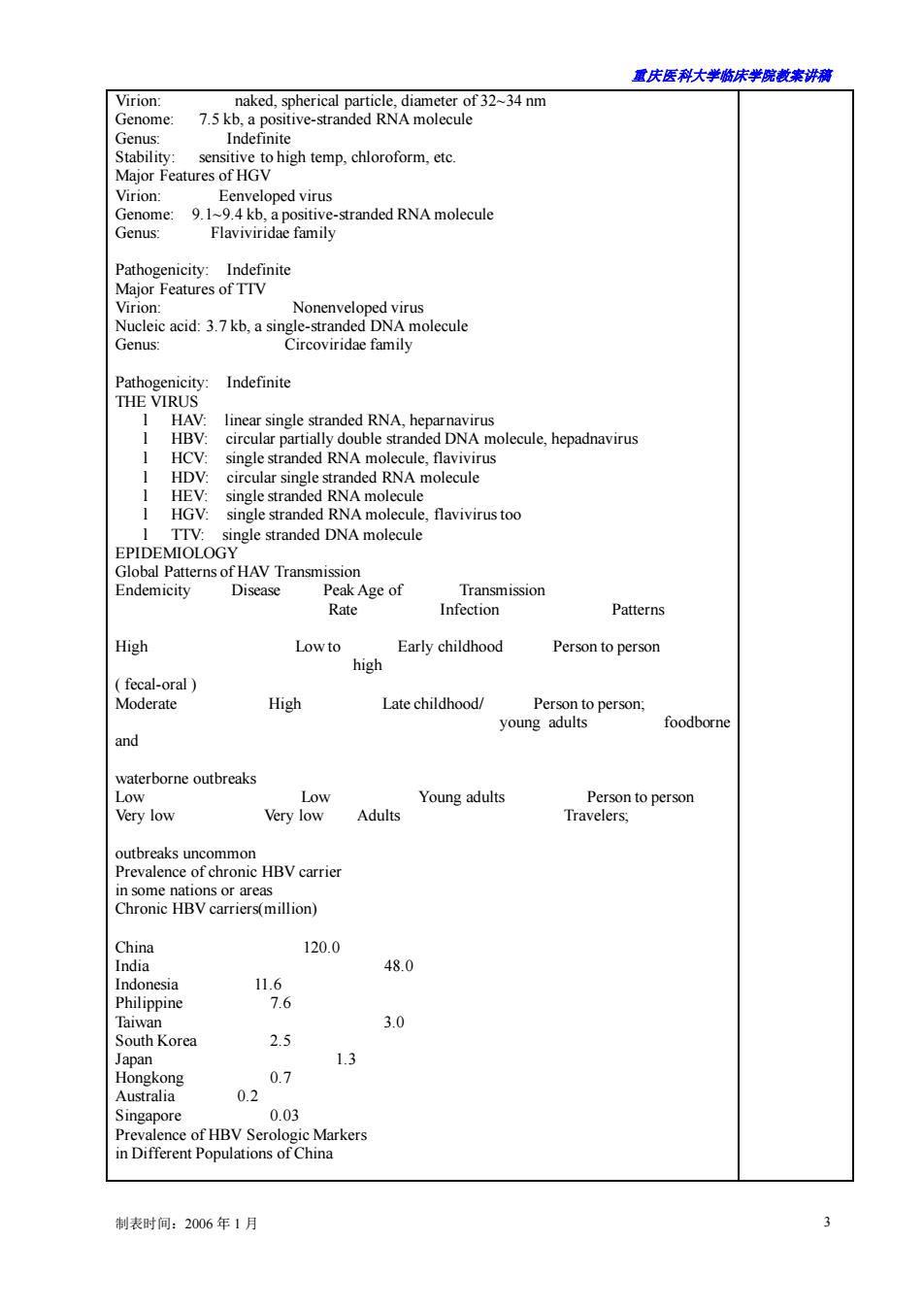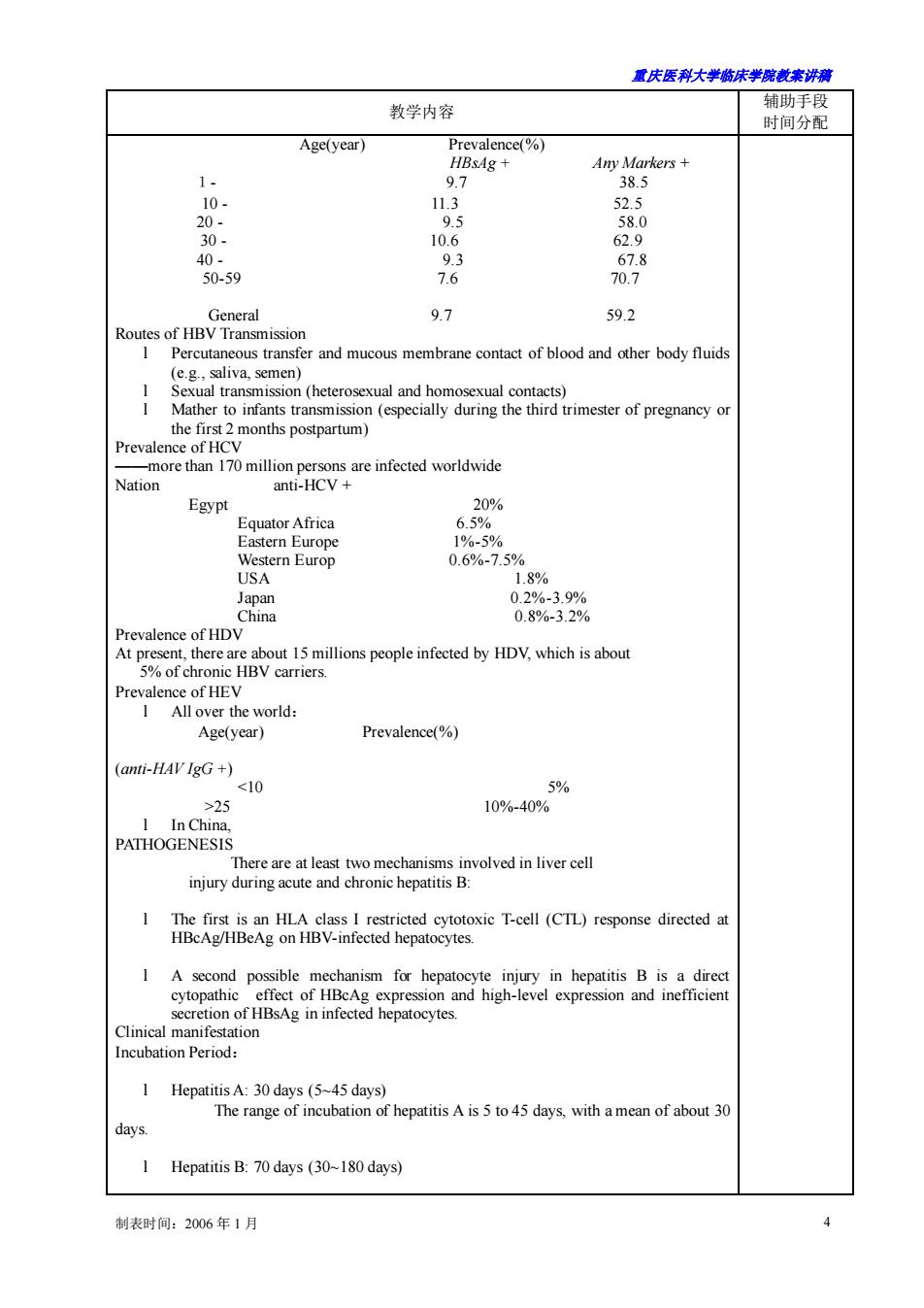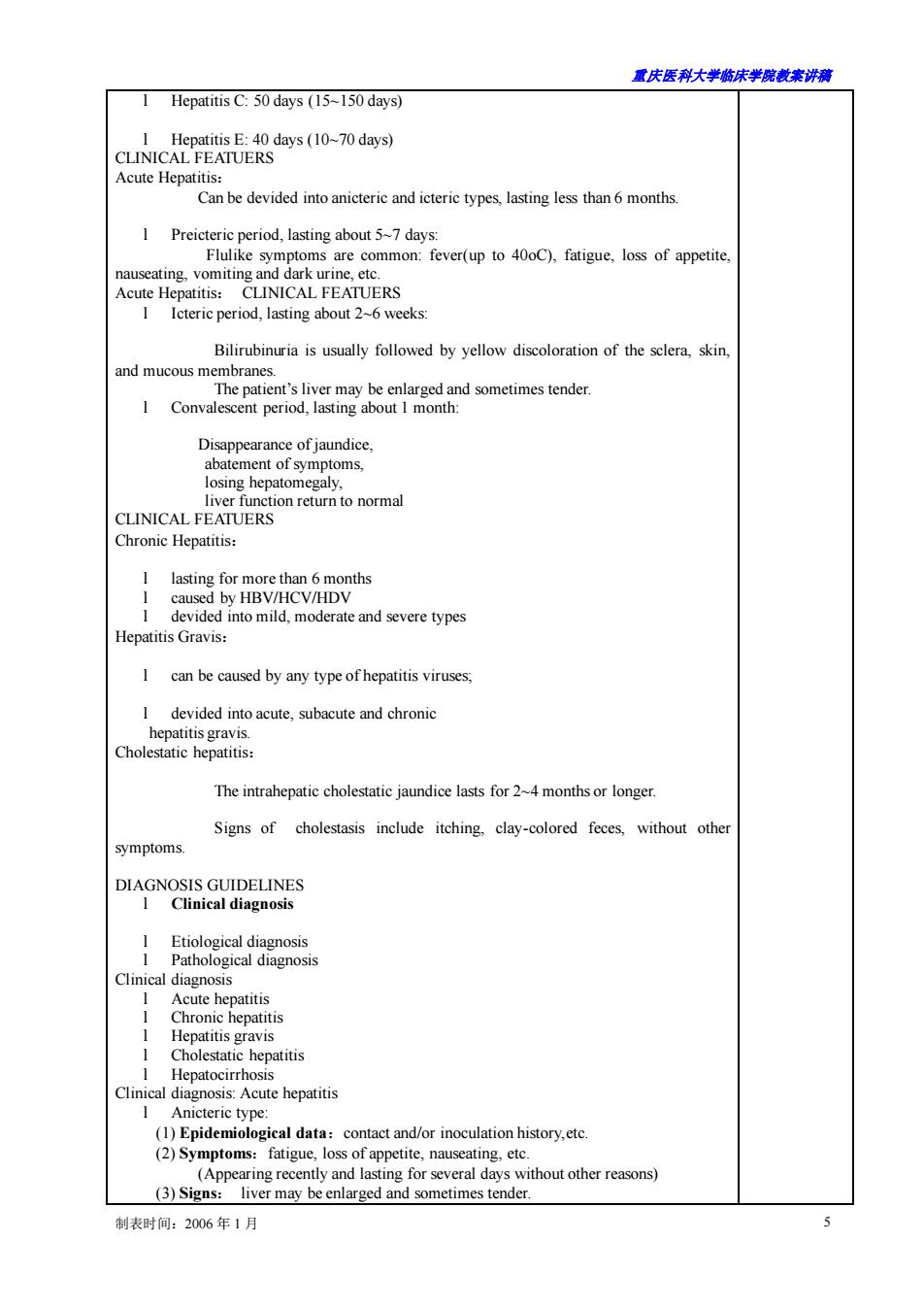
置庆医科大学脑床学院藏未讲满 重庆医科大学临床学院教案及讲稿 (教案) 课程名称传染病学 年级2004级 授课专业 教师姚云清 职称教授 授课方式 大课示教学时 题目章节Viral Hepatitis 教材名称 作者 出版社 版次 的要求 教学难点 教学重 处 手段 资料 教学组长: 教研室主任: 年 月 制表时间:2006年1月
重庆医科大学临床学院教案讲稿 制表时间:2006 年 1 月 1 重庆医科大学临床学院教案及讲稿 (教 案) 课程名称 传染病学 年级 2004 级 授课专业 教 师 姚云清 职称 教授 授课方式 大课 示教 学时 题目章节 Viral Hepatitis 教材名称 作者 出 版 社 版次 教 学 目 的 要 求 教 学 难 点 教 学 重 点 外语 要求 教学 方法 手段 参考 资料 教研 室意 见 教学组长: 教研室主任: 年 月 日

露庆医科大学临床半蕊载案讲满 (讲稿) 教学内容 辅助手段 时间分配 Viral Hepatitis I Viral etiology Clinical manifestation : Diagnosis on uide THE VIRUS HCV: hepatitisC virus 1 HGV:hepatitis G virus Major Features onusion transmited spherical particle,diameter of27m Genome:Single-stranded linear RNA,7.5kb Genus: Heparnavirus,within the Picornaviridae family Major Features of HBV Virion: nm Genome:3.2kb circular DNA,having four ORF in Ag-Ab systems:HBSAg-Ab HBV Stability omplete Condition Stable Inactivation Heat 60oC for4 hr 100oC for 10 min Major Features of HCV Stemusaivindae ay mesooC for 10 hr.100cfor mn Formalin Chloroform 10%-20%(v/w),6hr Genome: circular RNA molecule Heat 100oC for 5min 制表时间:2006年1月
重庆医科大学临床学院教案讲稿 制表时间:2006 年 1 月 2 (讲 稿) 教学内容 辅助手段 时间分配 Viral Hepatitis Contents l Viral etiology l Epidemiology l Pathogenesis l Clinical manifestation l Diagnosis l Treatment l Prevention guide THE VIRUS l HAV: hepatitis A virus l HBV: hepatitis B virus l HCV: hepatitis C virus l HDV: hepatitis D virus l HEV: hepatitis E virus l HGV:hepatitis G virus l TTV: transfusion transmitted virus Major Features of HAV Virion: Naked, spherical particle, diameter of 27nm Genome: Single-stranded linear RNA, 7.5kb Genus: Heparnavirus, within the Picornaviridae family Stability: Room temp for 1 wk, 85oC for 1 sec, UV for 1 sec, in 70% alcohol for 3 min Major Features of HBV Virion: Enveloped, spherical particle, diameter of 42 nm, intermal core is 28 nm. Genome: 3.2kb circular DNA, having four ORF in the complete strand, C, S, P and X genes. Genus: Hepadnavirus(HBV, WHV, GSHV, DHBV) Ag-Ab systems: HBsAg-Ab HBeAg-Ab HBcAg-Ab(IgG, IgM) HBV Stability Complete Condition Stable Inactivation Heat 60oC for 4 hr 100oC for 10 min Major Features of HCV Virion: Enveloped, spherical particle, diameter of 50-55 nm Nucleic acid: 9.4 kb, a positive-stranded RNA molecule Genus: Flaviviridae family member Stability: Heat 60oC for 10 hr, 100oC for 5min Formalin 1:1000, 37oC, 6 hr Chloroform 10%-20%(v/v), 6 hr Major Features of HDV Virion: HBsAg enveloped, spherical particle, diameter of 35-37 nm Genome: 1.78 kb, a negative-stranded, closed circular RNA molecule Stability: Heat 100oC for 5min Major Features of HEV

重庆医科大半床半院载未讲满 Virion: enome: 75 Stabili sensitiv to high temp.chloroform,etc. Major Features of HG viru e-stranded RNA molecule Genus: Flaviviridae family Pathogenicity:Indefinite Major Features of TTV Genus: Circoviridae family ty:Indefinite THE VIRUS HCV single stranded RNA molecule.flavivirus HDV: circular single stranded RNA molecule ded RNA mo e flavivirus too TTV: stranded DNA mocue HAV Transm Endemicity Disease Peak Age of Transmission Rate Infection Patterns High Lowto Early childhood Person to person high High Latechildhood/ foodborne and waterborne outbreaks Low Young adults Very low Adults outbreaks uncommon n some nations or areas HBV carrier Chronic HBV carriers(million) China 120.0 India 48.0 11 6 Taiwa 3.0 th Korea 25 Hongkong 0.2 0.7 003 Prevalence of HBV Serologic Markers in Different Populations of China 制表时间:2006年1月 3
重庆医科大学临床学院教案讲稿 制表时间:2006 年 1 月 3 Virion: naked, spherical particle, diameter of 32~34 nm Genome: 7.5 kb, a positive-stranded RNA molecule Genus: Indefinite Stability: sensitive to high temp, chloroform, etc. Major Features of HGV Virion: Eenveloped virus Genome: 9.1~9.4 kb, a positive-stranded RNA molecule Genus: Flaviviridae family Pathogenicity: Indefinite Major Features of TTV Virion: Nonenveloped virus Nucleic acid: 3.7 kb, a single-stranded DNA molecule Genus: Circoviridae family Pathogenicity: Indefinite THE VIRUS l HAV: linear single stranded RNA, heparnavirus l HBV: circular partially double stranded DNA molecule, hepadnavirus l HCV: single stranded RNA molecule, flavivirus l HDV: circular single stranded RNA molecule l HEV: single stranded RNA molecule l HGV: single stranded RNA molecule, flavivirus too l TTV: single stranded DNA molecule EPIDEMIOLOGY Global Patterns of HAV Transmission Endemicity Disease Peak Age of Transmission Rate Infection Patterns High Low to Early childhood Person to person high ( fecal-oral ) Moderate High Late childhood/ Person to person; young adults foodborne and waterborne outbreaks Low Low Young adults Person to person Very low Very low Adults Travelers; outbreaks uncommon Prevalence of chronic HBV carrier in some nations or areas Chronic HBV carriers(million) China 120.0 India 48.0 Indonesia 11.6 Philippine 7.6 Taiwan 3.0 South Korea 2.5 Japan 1.3 Hongkong 0.7 Australia 0.2 Singapore 0.03 Prevalence of HBV Serologic Markers in Different Populations of China

露庆医科大学临床半蕊裁案讲满 教学内容 辅助手段 时间分配 Age(year) Prevalence(%) Any Markers+ 1 8.5 000 113 525 50-59 Roule of 9.7 59.2 rnd muu membrane o ofad her bodyu o(heterosexual and homosexual contacts) Mather to infants transmission(especially during the third trimester of pregnancyo Prevaler en7 Nation Egypt 04 Equator Africa 6.5 50/ USA 1.8% aonwn 033% Apeoplen DVich isabout carriers Petherld. Age(year) Prevalence(%) (anti-HAV IgG+) <10 25 1 In Chi 109%40,% PATHOGENESIS h T-l (CT) 1 A second possible mechanism for hepatocyte injury in hepatitis B is a direc Clinical manifestation Incubation Period: I Hepatitis A:30 days (5-45 days) The range of incubation of hepatitis A is 5 to45 days,with amean of about 30 days. I Hepatitis B:70 days(30-180 days) 制表时间:2006年1月
重庆医科大学临床学院教案讲稿 制表时间:2006 年 1 月 4 教学内容 辅助手段 时间分配 Age(year) Prevalence(%) HBsAg + Any Markers + 1- 9.7 38.5 10 - 11.3 52.5 20 - 9.5 58.0 30 - 10.6 62.9 40 - 9.3 67.8 50-59 7.6 70.7 General 9.7 59.2 Routes of HBV Transmission l Percutaneous transfer and mucous membrane contact of blood and other body fluids (e.g., saliva, semen) l Sexual transmission (heterosexual and homosexual contacts) l Mather to infants transmission (especially during the third trimester of pregnancy or the first 2 months postpartum) Prevalence of HCV ——more than 170 million persons are infected worldwide Nation anti-HCV + Egypt 20% Equator Africa 6.5% Eastern Europe 1%-5% Western Europ 0.6%-7.5% USA 1.8% Japan 0.2%-3.9% China 0.8%-3.2% Prevalence of HDV At present, there are about 15 millions people infected by HDV, which is about 5% of chronic HBV carriers. Prevalence of HEV l All over the world: Age(year) Prevalence(%) (anti-HAV IgG +) <10 5% >25 10%-40% l In China, PATHOGENESIS There are at least two mechanisms involved in liver cell injury during acute and chronic hepatitis B: l The first is an HLA class I restricted cytotoxic T-cell (CTL) response directed at HBcAg/HBeAg on HBV-infected hepatocytes. l A second possible mechanism for hepatocyte injury in hepatitis B is a direct cytopathic effect of HBcAg expression and high-level expression and inefficient secretion of HBsAg in infected hepatocytes. Clinical manifestation Incubation Period: l Hepatitis A: 30 days (5~45 days) The range of incubation of hepatitis A is 5 to 45 days, with a mean of about 30 days. l Hepatitis B: 70 days (30~180 days)

重庆医科大半临床半院载未讲满 I Hepatitis C:50 days(15-150 days) Acute Hepatitis: Can be devided into anicteric and icteric types lasting less than6 months IPreicteric period,lasting about 5-7 days: Fsymptomaremon:fever(up to 40C)fatigue,os of appetite 1 Icteric period,lasting about 2~6 weeks Disappearance ofjaundice. abat ment of symptoms. ion return to normal Chronic Hepatitis: I lasting for more than 6 months moderate and severe types Hepatitis Gravis: I can be caused by any type ofhepatitis viruses. 1 devided into acute.subacute and chronic hepatitis gravis The intrahepatic cholestatic jaundice lasts for 2~4 months or longer ymptoms. Signs of cholestasis include itching.clay-olored feces.without othe Clinical diagnosis IAcute hepatitis Cholestatic hepatitis Anicteric type: (1)Epidemiological data:contact and/or inoculation history.etc. (2)Symptoms:fatigue,loss of appetite,nauseating,etc. without other reasons) (3)Signs: 制表时间:2006年1月
重庆医科大学临床学院教案讲稿 制表时间:2006 年 1 月 5 l Hepatitis C: 50 days (15~150 days) l Hepatitis E: 40 days (10~70 days) CLINICAL FEATUERS Acute Hepatitis: Can be devided into anicteric and icteric types, lasting less than 6 months. l Preicteric period, lasting about 5~7 days: Flulike symptoms are common: fever(up to 40oC), fatigue, loss of appetite, nauseating, vomiting and dark urine, etc. Acute Hepatitis: CLINICAL FEATUERS l Icteric period, lasting about 2~6 weeks: Bilirubinuria is usually followed by yellow discoloration of the sclera, skin, and mucous membranes. The patient’s liver may be enlarged and sometimes tender. l Convalescent period, lasting about 1 month: Disappearance of jaundice, abatement of symptoms, losing hepatomegaly, liver function return to normal CLINICAL FEATUERS Chronic Hepatitis: l lasting for more than 6 months l caused by HBV/HCV/HDV l devided into mild, moderate and severe types Hepatitis Gravis: l can be caused by any type of hepatitis viruses; l devided into acute, subacute and chronic hepatitis gravis. Cholestatic hepatitis: The intrahepatic cholestatic jaundice lasts for 2~4 months or longer. Signs of cholestasis include itching, clay-colored feces, without other symptoms. DIAGNOSIS GUIDELINES l Clinical diagnosis l Etiological diagnosis l Pathological diagnosis Clinical diagnosis l Acute hepatitis l Chronic hepatitis l Hepatitis gravis l Cholestatic hepatitis l Hepatocirrhosis Clinical diagnosis: Acute hepatitis l Anicteric type: (1) Epidemiological data:contact and/or inoculation history,etc. (2) Symptoms:fatigue, loss of appetite, nauseating, etc. (Appearing recently and lasting for several days without other reasons) (3) Signs: liver may be enlarged and sometimes tender